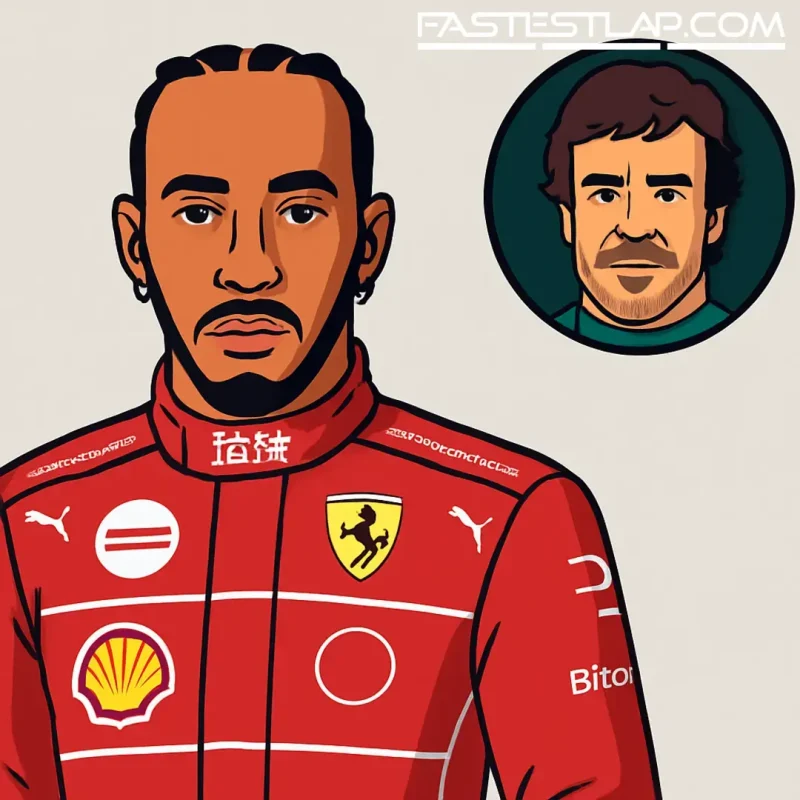Fernando Alonso knows exactly what it feels like when a car won’t speak your language.
As Lewis Hamilton wrestles with the nuances of Ferrari’s SF-25 this season, Alonso has looked back at his own culture shock in 2007 and called that year’s McLaren an “anti-Fernando car” — a machine that demanded a different dialect at every corner and punished any attempt to drive it his way.
Alonso arrived at McLaren as a reigning double World Champion, fresh from back-to-back titles with Renault. He had the trophies, the aura, the momentum. And then, almost immediately, he hit a wall: different brakes, different tyres, a rookie teammate with frightening pace, and a team ensnared in what became the infamous Spygate saga. McLaren was fined $100 million and kicked out of the Constructors’ Championship, while both Alonso and Hamilton ended the year one point shy of Kimi Räikkönen’s title. It was fierce, fraught, and often joyless.
The technical mismatch was real. Alonso had been wedded to Hitco brake material at Renault; McLaren used Carbon Industrie. The “feel” — that tiny window between bite and lock-up where confidence lives — just wasn’t there. McLaren even switched Alonso’s car to Hitco later in the season to help him settle. And there was the rubber. Michelin, so central to his Renault years, had left F1 at the end of 2006, forcing Alonso onto Bridgestones at McLaren. Hamilton, fresh out of GP2, had been living on Bridgestones. Advantage rookie.
“Surely there were some [cars that didn’t suit me], but that’s an excuse that doesn’t work,” Alonso told AS. “You have to adapt because cars change and rules change. Without going any further, as soon as the second World Championship ended, I had an ‘anti-Fernando’ car in 2007.”
That line hits differently in 2025, because we’re watching Hamilton — at 40, the other elder statesman on the grid alongside the 44-year-old Alonso — go through his own conversion course at Ferrari.
Hamilton spent 12 seasons at Mercedes, collecting six of his seven titles and hard-wiring himself to their toolkit, including Carbon Industrie brakes. Ferrari is a different religion. Maranello has long danced with Brembo, and the red cars pair that with their own engine-braking philosophy. The pedal is heavier, the bite is different, the way the rear helps you slow the car isn’t what his right foot expects. Those micro-moments — the last four metres before the apex — are where lap time either appears or vanishes.
From his very first mileage at Fiorano back in January, Hamilton flagged the brakes as an area he had to get on top of. The theme didn’t go away. His odd spin at the Bus Stop in Spa sprint qualifying — a lazy loop on his final lap that dumped him out in SQ1 — raised eyebrows and, from Hamilton, mention of a “new component” on the car. It’s understood Ferrari had revised its combination of Brembo discs and pads, the sort of detail that can tip the feel from familiar to alien in an instant.
The turnaround, predictably, hasn’t been linear. There have been glimpses of harmony. At Monza, Hamilton was closer to Charles Leclerc on outright pace, topping opening practice and missing out on his teammate by a tenth in qualifying before a carry-over grid penalty bit. In Baku he looked sharp again in practice — and then qualifying got away from him, leaving a recovery job for Sunday.
And then came the awkward stuff. Ferrari tried to play the team game late in Baku, with Leclerc agreeing to let Hamilton through to chase cars ahead on an alternate strategy. The expectation was that places would be swapped back if the move didn’t pan out. It didn’t — and the swap-back never came before the flag, despite Hamilton easing up on the run to the line. Leclerc was audibly unimpressed, calling the situation “not fair” on the radio. In the Ferrari universe, those little moments linger.
Strip away the noise, though, and the pattern is familiar. New team, new muscle memory, and no shortcut to that last layer of confidence on the brake pedal. Alonso’s point isn’t that a car can be “wrong” for a driver forever. It’s that the first weeks — sometimes months — can feel like a bad translation until you find the cadence.
“The tyres were Bridgestone, which were the same ones used in GP2 at the time, so all the drivers who moved up from GP2 [like Hamilton] suddenly had very good performance,” Alonso said of 2007. “I’ve suffered for a few years, but that’s the way it is.”
Swap tyres for brake material, and it starts to rhyme. Hamilton’s still Hamilton — the instincts are intact. Give him circuits with heavy braking, repeatable reference points and a car that does what it says on the tin and he edges back to himself. The task now is turning flashes into a baseline while Ferrari keeps refining the package underneath him.
Two decades on from Alonso’s first title, the sport’s two most seasoned operators are still here, still quick, and still navigating the same old truth: in Formula 1, performance lives in the details you can’t see — and sometimes, the hardest part of changing teams is learning how to stop.




